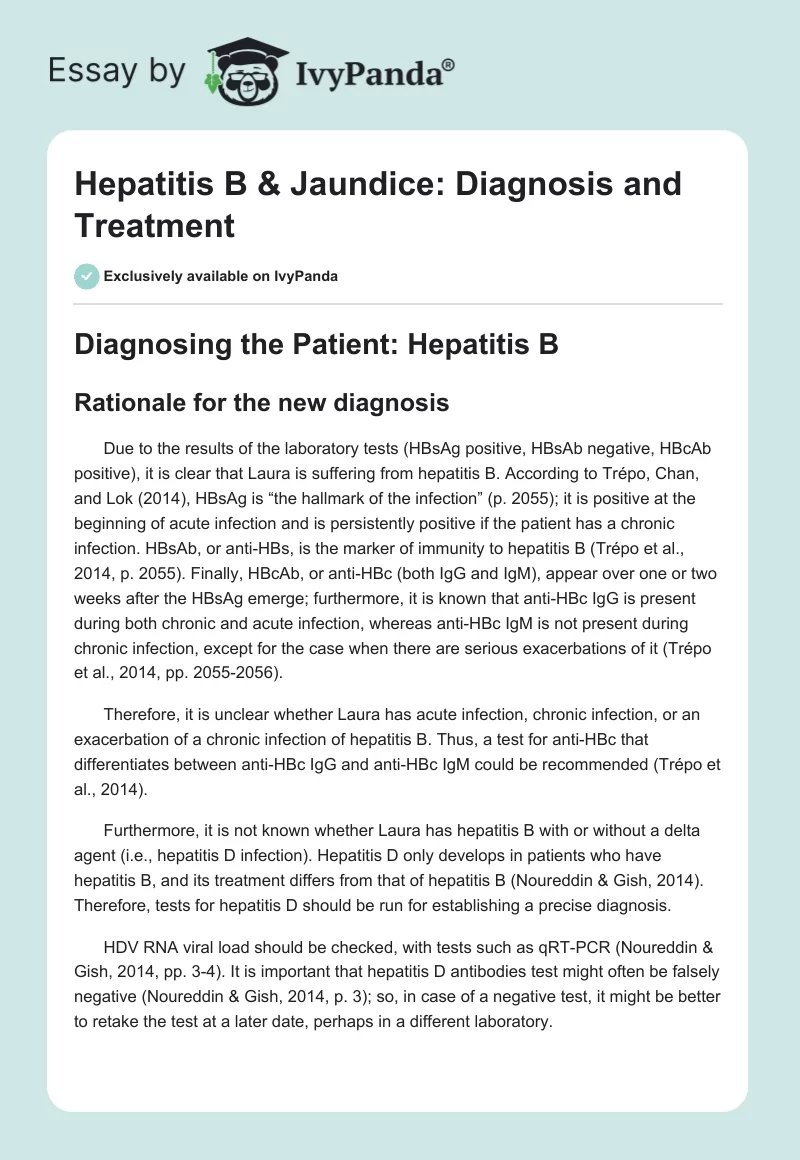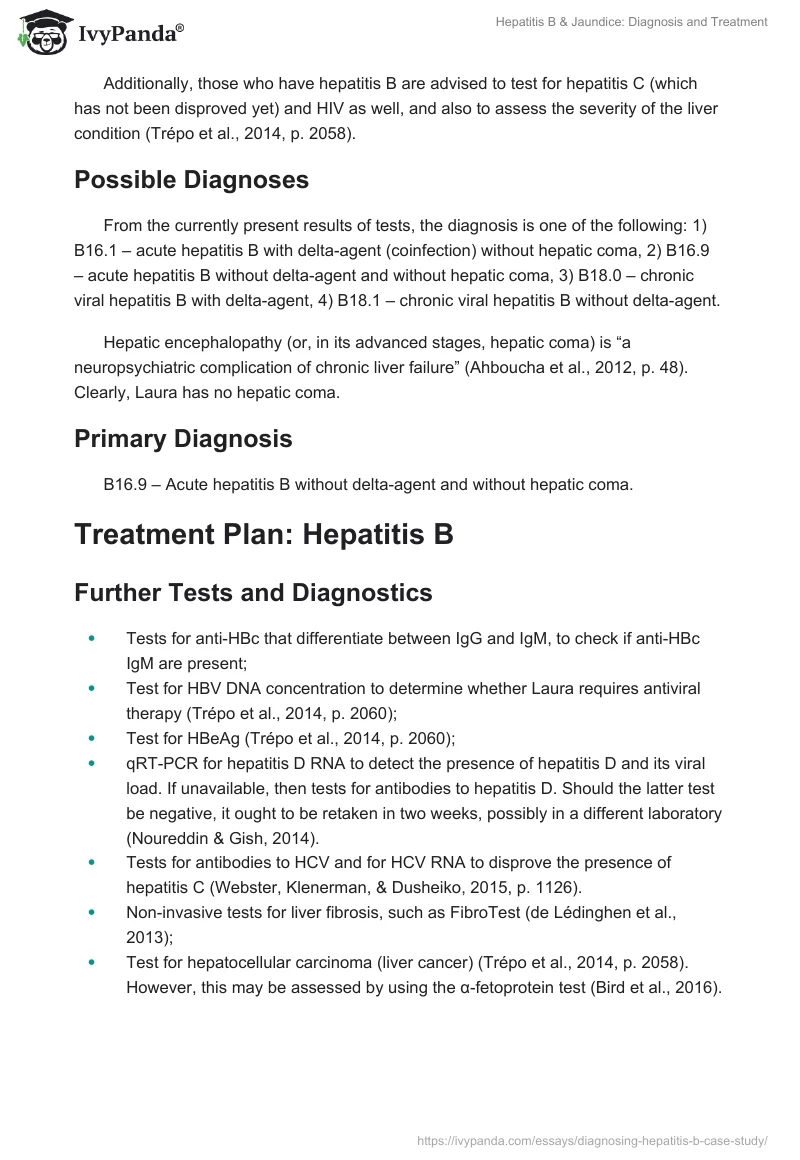Diagnosing the Patient: Hepatitis B
Rationale for the new diagnosis
Due to the results of the laboratory tests (HBsAg positive, HBsAb negative, HBcAb positive), it is clear that Laura is suffering from hepatitis B. According to Trépo, Chan, and Lok (2014), HBsAg is “the hallmark of the infection” (p. 2055); it is positive at the beginning of acute infection and is persistently positive if the patient has a chronic infection. HBsAb, or anti-HBs, is the marker of immunity to hepatitis B (Trépo et al., 2014, p. 2055). Finally, HBcAb, or anti-HBc (both IgG and IgM), appear over one or two weeks after the HBsAg emerge; furthermore, it is known that anti-HBc IgG is present during both chronic and acute infection, whereas anti-HBc IgM is not present during chronic infection, except for the case when there are serious exacerbations of it (Trépo et al., 2014, pp. 2055-2056).
Therefore, it is unclear whether Laura has acute infection, chronic infection, or an exacerbation of a chronic infection of hepatitis B. Thus, a test for anti-HBc that differentiates between anti-HBc IgG and anti-HBc IgM could be recommended (Trépo et al., 2014).
Furthermore, it is not known whether Laura has hepatitis B with or without a delta agent (i.e., hepatitis D infection). Hepatitis D only develops in patients who have hepatitis B, and its treatment differs from that of hepatitis B (Noureddin & Gish, 2014). Therefore, tests for hepatitis D should be run for establishing a precise diagnosis.
HDV RNA viral load should be checked, with tests such as qRT-PCR (Noureddin & Gish, 2014, pp. 3-4). It is important that hepatitis D antibodies test might often be falsely negative (Noureddin & Gish, 2014, p. 3); so, in case of a negative test, it might be better to retake the test at a later date, perhaps in a different laboratory.
Additionally, those who have hepatitis B are advised to test for hepatitis C (which has not been disproved yet) and HIV as well, and also to assess the severity of the liver condition (Trépo et al., 2014, p. 2058).
Possible Diagnoses
From the currently present results of tests, the diagnosis is one of the following: 1) B16.1 – acute hepatitis B with delta-agent (coinfection) without hepatic coma, 2) B16.9 – acute hepatitis B without delta-agent and without hepatic coma, 3) B18.0 – chronic viral hepatitis B with delta-agent, 4) B18.1 – chronic viral hepatitis B without delta-agent.
Hepatic encephalopathy (or, in its advanced stages, hepatic coma) is “a neuropsychiatric complication of chronic liver failure” (Ahboucha et al., 2012, p. 48). Clearly, Laura has no hepatic coma.
Primary Diagnosis
B16.9 – Acute hepatitis B without delta-agent and without hepatic coma.
Treatment Plan: Hepatitis B
Further Tests and Diagnostics
- Tests for anti-HBc that differentiate between IgG and IgM, to check if anti-HBc IgM are present;
- Test for HBV DNA concentration to determine whether Laura requires antiviral therapy (Trépo et al., 2014, p. 2060);
- Test for HBeAg (Trépo et al., 2014, p. 2060);
- qRT-PCR for hepatitis D RNA to detect the presence of hepatitis D and its viral load. If unavailable, then tests for antibodies to hepatitis D. Should the latter test be negative, it ought to be retaken in two weeks, possibly in a different laboratory (Noureddin & Gish, 2014).
- Tests for antibodies to HCV and for HCV RNA to disprove the presence of hepatitis C (Webster, Klenerman, & Dusheiko, 2015, p. 1126).
- Non-invasive tests for liver fibrosis, such as FibroTest (de Lédinghen et al., 2013);
- Test for hepatocellular carcinoma (liver cancer) (Trépo et al., 2014, p. 2058). However, this may be assessed by using the α-fetoprotein test (Bird et al., 2016).
Medication
Rx: Viread (tenofovir disoproxil fumarate) 300 mg. Sig: 1 tablet daily. Disp: #30. Refill: #3 (Pereira et al., 2016; Jindal, Kumar, & Sarin, 2013, p. 167; Aleman, van den Berk, Franssen, & de Fijter, 2015).
Conservative Measures
It is necessary for the patient to avoid further unprotected sexual contacts to avoid catching other infections and to avoid infecting her partners (Goroll & Mulley, 2014). Alcohol should be avoided so as not to harm the liver further (Trépo et al., 2014).
Education
The patient should be educated about the ways hepatitis B and HIV are transferred, and the necessity to use condoms during sex, as well as about the need to ensure that invasive instruments and needles (such as ones on syringes or tools for making tattoos) are sterile. It should be explained that the patient should restrain from consumption of alcohol and foods that harm the liver (Trépo et al., 2014, p. 2058).
Referrals
Laura should consult with a gastroenterologist/hepatologist. She should be admitted to the hospital, for she has jaundice (Buttaro et al., 2013, p. 675).
Follow-Ups
Laura should be observed in the long term, regularly test her viral loads, and visit a physician at least once every two months (Buttaro et al., 2013).
Diagnosing the Patient: Jaundice
Diagnosis: Unspecified jaundice (R17).
The rationale for this diagnosis is the color of the patient’s skin (“slightly jaundiced”), and certain symptoms that are typical of jaundice: satiety and decreased appetite, seizures, and weight loss (Abbas, Shamshad, Ashraf, & Javaid, 2016). The fact that Laura has some form of hepatitis B further increases the likelihood of jaundice.
Further Tests and Diagnostics
To ensure that Laura has jaundice, and to identify the type of jaundice (pre-hepatic, hepatic, or post-hepatic), it is needed to take blood tests for bilirubin (both conjugated and unconjugated), and urobilinogen in the serum (Abbas et al., 2016, p. 1316). In addition, the tests for alkaline phosphatase, alanine transferase, and aspartate transferase will be normal if the jaundice is pre-hepatic (Abbas et al., 2016, p. 1316), which allows for supposing that Laura has pre-hepatic jaundice because ALT and AST tests were normal.
Treatment Plan: Jaundice
Medications and Procedures
Jaundice is usually treated by addressing its causes (Buttaro et al., 2013, p. 693; Abbas et al., 2016). However, it is possible to reduce the levels of bilirubin by using phototherapy (Abbas et al., 2016, p. 1316). Therefore, Laura should attend phototherapy sessions.
Prescription
1) Laevolac (lactulose) 10 g / 15 ml (oral solution sachets). Sig: 2 sachets three times per day. Disp: #30. Refill: #3. This will reduce the levels of ammonia in the blood and safeguard Laura from encephalopathy (Buttaro et al., 2013, p. 693).
Referrals
Laura should see a gastroenterologist and a pathologist, as well as a surgeon; in addition, she should be admitted to the hospital (Buttaro et al., 2013, p. 693).
Conservative Measures
Laura should use a diet that is low in fats and high in water (Abbas et al., 2016).
Patient Education
The patient should be educated about the causes of jaundice, as well as about the prevention of these causes (in Laura’s case, it is likely to be hepatitis B, at least partially). She needs to avoid OTC drugs which are harmful to the liver, and comply with her diet; she also should stop consuming alcohol (Buttaro et al., 2013, p. 693; Abbas et al., 2016).
Follow-Up Plan
Laura should be observed in the long term due to her hepatitis B (Buttaro et al., 2013). After the discharge from the hospital, she needs to visit her physician at least once every two months. The physician needs to monitor her liver function, in addition to the viral load of HBV.
References
Abbas, M. W., Shamshad, T., Ashraf, M. A., & Javaid, R. (2016). Jaundice: A basic review.International Journal of Research in Medical Sciences, 4(5), 1313-1319. Web.
Ahboucha, S., Talani, G., Fanutza, T., Sanna, E., Biggio, G., Gamrani, H., & Butterworth, R. G. (2012). Reduced brain levels of DHEAS in hepatic coma patients: Significance for increased GABAergic tone in hepatic encephalopathy. Neurochemistry International, 61(1), 48-53. Web.
Aleman, J., van den Berk, G. E. L., Franssen, E. J. F., & de Fijter, C. W. H. (2015). Tenofovir disoproxil treatment for a HIV-hepatitis B virus coinfected patient undergoing peritoneal dialysis: which dose do we need? AIDS, 29(12), 1579-1580. Web.
Bird, T. G., Dimitropoulou, P., Turner, R. M., Jenks, S. J., Cusack, P., Hey, S.,…Bird, S. M. (2016). Alpha-fetoprotein detection of hepatocellular carcinoma leads to a standardized analysis of dynamic AFP to improve screening based detection.PLoS One, 11(6), e0156801. Web.
Buttaro, T.M., Trybulski, J., Bailey, P., & Sandburg-Cook, J. (2013). Primary care: A collaborative practice (4th ed.). St. Louis, MO: Elsevier Mosby.
De Lédinghen, V., Vergniol, J., Barthe, C., Foucher, J., Chermak, F., Le Bail, B.,…Bernard, P. H. (2013). Non-invasive tests for fibrosis and liver stiffness predict 5-year survival of patients chronically infected with hepatitis B virus.Alimentary Pharmacology & Therapeutics, 37(10), 979-988. Web.
Goroll, A. H., & Mulley, A. G. (2014). Primary care medicine: Office evaluation and management of the adult patient (7th ed.). Beijing, China: Wolters Kluwer.
Jindal, A., Kumar, M., & Sarin, S. K. (2013). Management of acute hepatitis B and reactivation of hepatitis B. Liver International, 33, 164-175.
Noureddin, M., & Gish, R. (2014). Hepatitis delta: Epidemiology, diagnosis and management. 36 years after discovery.Current Gastroenterology Reports, 16(365), 1-8. Web.
Pereira, C. V., Tovo, C. V., Grossmann, T. K., Mirenda, H., Dal-Pupo, B. B., de Almeida, P. R. L., & de Mattos, A. A. (2016). Efficacy of entecavir and tenofovir in chronic hepatitis B under treatment in the public health system in southern Brazil.Memórias do Instituto Oswaldo Cruz, 111(4), 252-257. Web.
Trépo, C., Chan, H. L. Y., & Lok, A. (2014). Hepatitis B virus infection. The Lancet, 384(9959):2053-2063.
Webster, D. P., Klenerman, P., & Dusheiko, G. M. (2015). Hepatitis C. The Lancet, 385(9973), 1124-1135.


